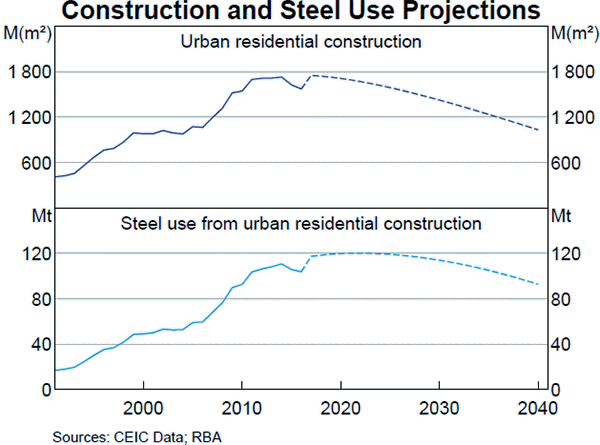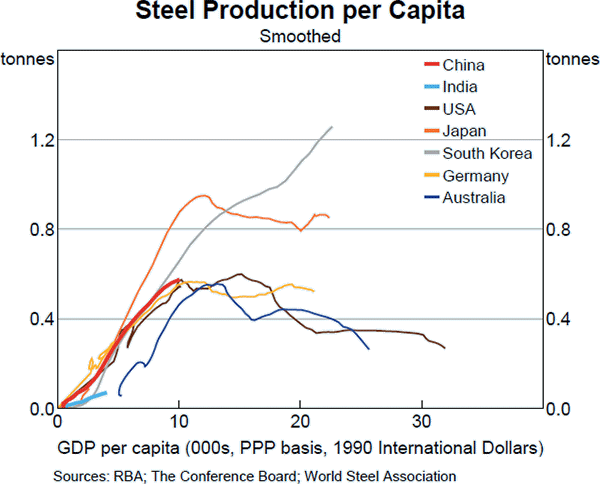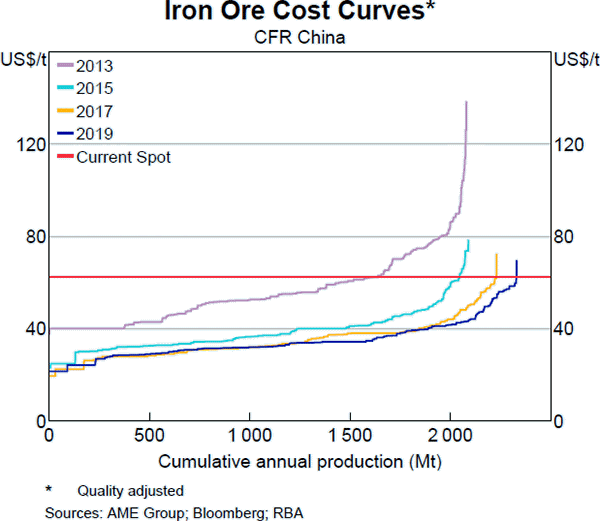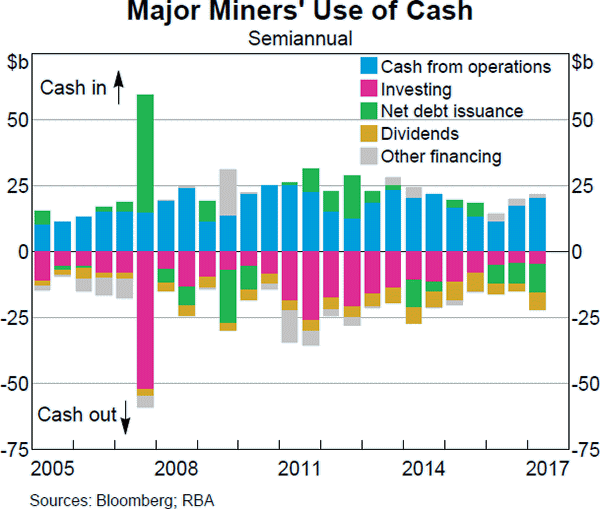Statement on Monetary Policy – November 2017 Box A: The Chinese Steel Market and Demand for Bulk Commodities
China is by far the largest consumer of iron ore and coking coal globally, primarily for use in the production of steel. It consumes more of these bulk commodities than it produces and so generates demand for bulk commodity exporters, such as Australia, which is the world's largest exporter of both commodities. Over the longer term, growth in Chinese demand for the inputs to steel production is likely to slow, which will affect the outlook for Australia's iron ore and coking coal exports. Stronger demand from other emerging economies could offset this to some extent.
There are a number of reasons to expect that Chinese demand for steel is near its peak, although there is considerable uncertainty around this projection. China's population is projected to fall in coming decades, and the current rate of urbanisation is likely to slow. Both factors would tend to reduce demand for steel needed to build urban housing and infrastructure. Partly offsetting this effect, though, urban housing could require more steel per unit as buildings become larger and taller (Graph A1).[1]

It is also possible that the amount of steel used per person, or ‘steel intensity’, has peaked. The steel intensity of the Chinese economy increased significantly during China's industrialisation and urbanisation since the 1990s, but this effect is likely to peter out as the economy shifts away from heavy industry and towards services (Graph A2). If so, China's experience would remain consistent with that of many advanced economies, where steel intensity rose with incomes, and then plateaued at a similar level to China's current steel intensity at around the same income level. The exceptions are economies that export a much larger share of their steel output; steel intensity peaked at a higher level in Japan and is still increasing in South Korea. For some emerging economies, such as India, the increase in steel intensity has been slower because of a less steel-intensive pattern of development, although further urbanisation and infrastructure investment could lift steel intensity in the future. Looking forward, China is unlikely to follow the same trajectory as Japan and South Korea because the level of exports this would imply (given the existing scale of its own domestic demand) would be extremely large relative to the rest of the world's current demand for steel; China already accounts for around a quarter of global steel exports.

Further increases in steel intensity would also be inconsistent with the Chinese Government's stated longer-term policy priorities with respect to environmental protection. Chinese authorities have recently intensified their commitment to reducing air pollution by implementing constraints on steel production, which is a heavy user of coal. Some of the policies announced so far include targeted reductions to steel production over the winter months in 28 cities located in regions where production collectively accounts for more than one-third of China's annual steel output. The effects of these restrictions on overall production might be ameliorated by shifting production to the summer months, to other provinces and to less-polluting steel mills.
Domestic steel demand is not expected to fall sharply, however, because the slowing in demand for construction-related steel is likely to be gradual, and some other sources of demand will continue to support Chinese steel production. For example, car ownership has been rising rapidly in China but remains very low relative to other economies (around 130 vehicles per thousand people, compared with more than 800 in the United States). Consequently, consumption and production of motor vehicles has considerable room to grow as household incomes rise. On the other hand, Chinese exports are likely to decline in coming years. The prices of a number of Chinese steel products have been increasing relative to the prices of steel exported from the United States and Europe. Also, numerous current or impending trade actions against Chinese steel exporters may limit the scope for China to increase its already large share of global steel trade.
On top of slowing demand for Chinese steel, demand for Australian iron ore and coking coal as inputs could be further affected if China increases the share of its production made from scrap metal. At around 11 per cent of domestic crude steel production, the current ratio of scrap steel consumption in China is low relative to many other large steel-producing economies (for example, the ratio exceeds 50 per cent in the European Union and 70 per cent in the United States). The Chinese Government aims to triple this ratio over the next decade.
Supply-side developments will also affect prices of these commodities. Global supply of iron ore has increased considerably over recent years and is expected to expand further in the period ahead following strong investment in production capacity. Australia (along with Brazil) is a low-cost producer of iron ore, and is therefore well placed to compete in the global market. The average variable cost of iron ore production is expected to decline, in part reflecting new low-cost supply from Australia and Brazil (Graph A3).[2]

The supply-side dynamics for coking coal are different because not much additional capacity is expected to come online over the next few years. However, the global seaborne market is small, which makes the spot price vulnerable to supply-side disruptions. Over the past year or so, the spot price for coking coal has been quite volatile, reflecting changes to production restrictions implemented by Chinese authorities and Tropical Cyclone Debbie that damaged infrastructure in Queensland's Bowen Basin. As these temporary factors dissipate, prices are expected to return to lower levels.
Given the easing in bulk commodity prices since 2011 and longer-term developments that point to further declines, it is no surprise that information from the Bank's liaison program suggests that there are no large new iron ore or coking coal mine projects due to commence construction in the near term in Australia. Most major miners have used the higher revenue stemming from the recent increases in commodity prices to pay down debt and return profits to shareholders (Graph A4). While there are a number of potential iron ore projects that could be developed in Australia, they would require expectations of sustained high prices and would take several years of planning and construction before commencing production.

Footnotes
For a discussion of the methodology on which these estimates are based, see Berkelmans L and H Wang (2012), ‘Chinese Urban Residential Construction to 2040’, RBA Research Discussion Paper No 2012-04. [1]
See RBA (2014), ‘Box B: Iron Ore and Cost Curves’, Statement on Monetary Policy, August, pp 18–20. [2]